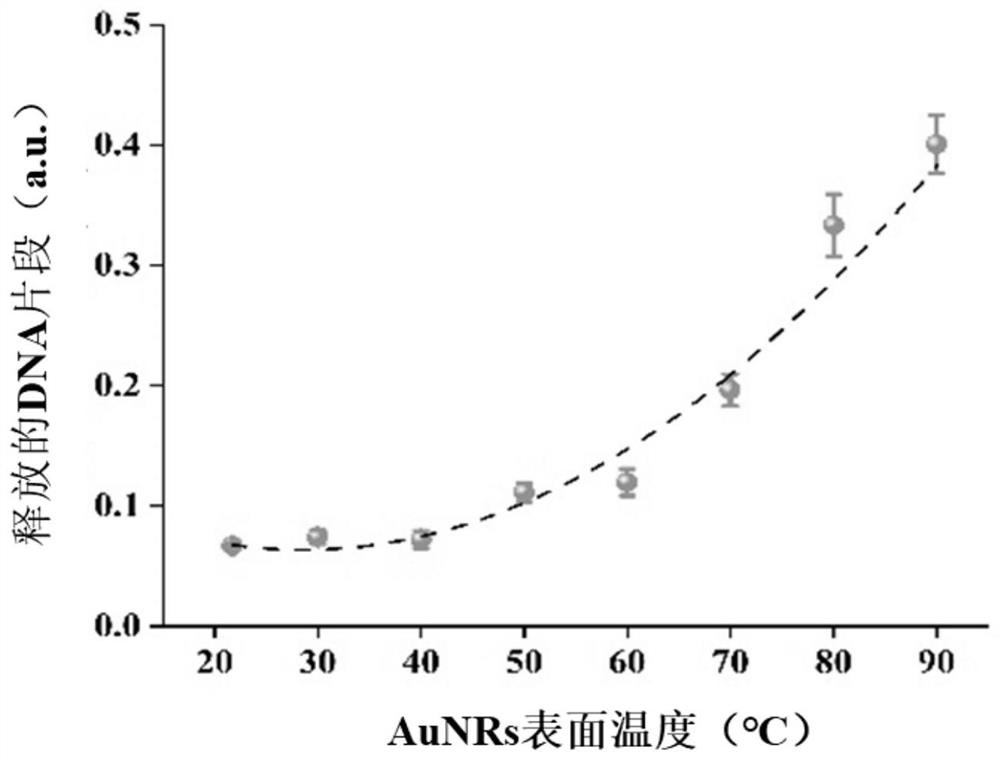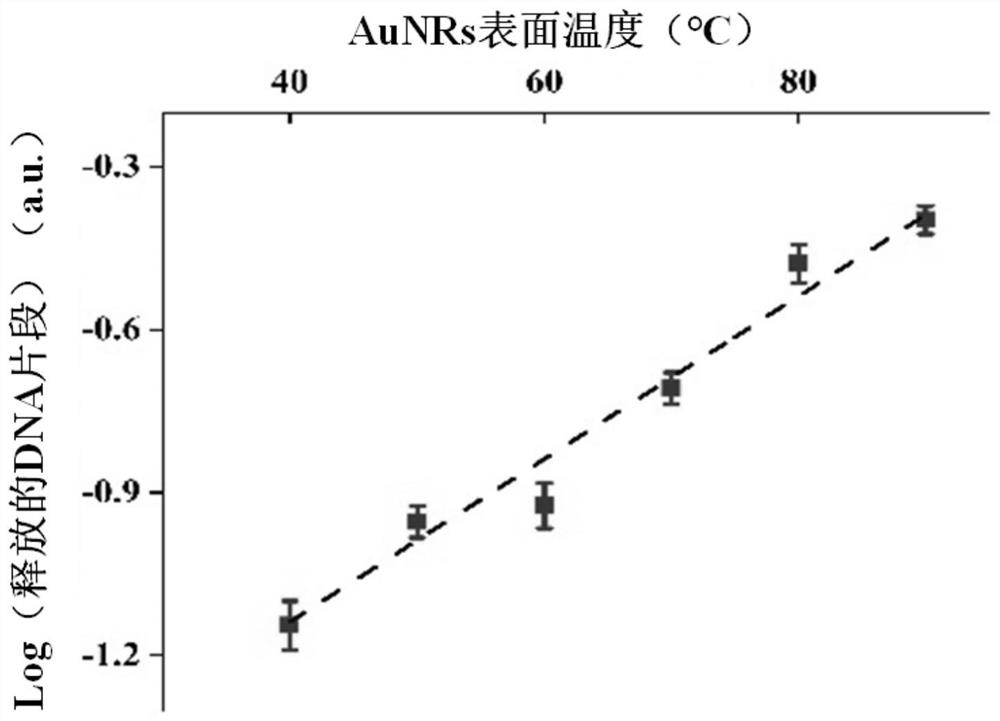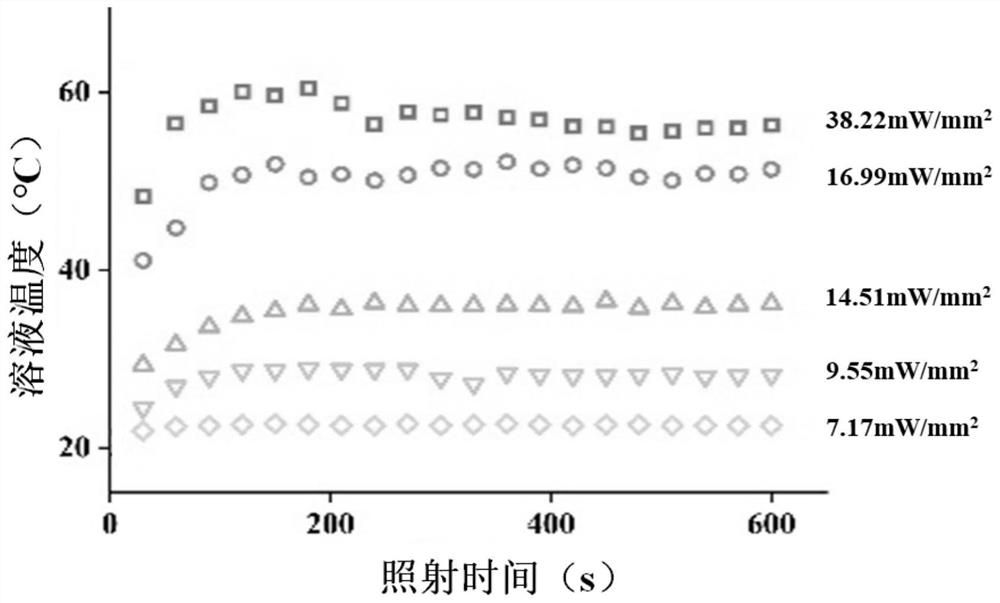Method for measuring surface temperature of gold nanorod, heat transmission device constructed by using gold nanorod, and application
A gold nanorod and surface temperature technology, applied in the measurement of the surface temperature of gold nanorods, a heat transfer device for the surface temperature field of gold nanorods, and the field of nucleic acid amplification based on nano-localized heating
- Summary
- Abstract
- Description
- Claims
- Application Information
AI Technical Summary
Problems solved by technology
Method used
Image
Examples
Embodiment 1
[0058] In this example, the instability of the gold-sulfur bond is used to provide an indirect method for measuring the surface temperature of AuNRs.
[0059] In order to clarify the relationship between the surface temperature of AuNRs and the dissociation of Au-S bonds, in this example, AuNRs-DNA was dispersed in a Tris buffer with a pH of 8, wherein the concentration of gold nanorods was 50 pM and the concentration of surface modification probes was 0.1 ×10 12 molecules / cm 2 (molecule / cm 2 ), and heat the entire solution to the design temperature using a dry bath. When the whole solution reaches a constant temperature, it is assumed that the surface temperature of AuNRs is the same as the solution temperature, and the solution temperature can be measured by an infrared thermal imaging camera.
[0060] Since the ends of the DNA probes have been modified with organic fluorescent dyes, the recovery of fluorescence can be observed when the DNA probes are released from the su...
Embodiment 2
[0067] This example was used to determine the effect of the power intensity of the incident laser light on the temperature gradient around AuNRs. Among them, the power intensity of the incident laser directly affects the input energy and the heat generated by AuNRs, resulting in the change of the surface temperature.
[0068] 46 pM AuNRs-DNA probes were dispersed in Tris buffer at pH 8, where the DNA probes were thiolated DNA probes consisting of a reaction region and a spacer region, where the reaction region was responsible for pairing with the target NA and initiating NA amplification , the polyadenine sequence in the spacer can adjust the distance from the reaction zone to the surface of AuNRs; and with five different intensities (7.17mW / mm 2 、9.55mW / mm 2 、14.51mW / mm 2 、16.99mW / mm 2 and 38.22mW / mm 2 ) with 808nm laser for excitation.
[0069] Such as image 3 As shown, the solution temperature increased sharply at the beginning and then reached a constant temperature...
Embodiment 3
[0074] This example was used to determine the effect of the solution concentration of AuNRs on the temperature gradient around AuNRs. Among them, the solution concentration of AuNRs will affect the absorption efficiency and scattering between incident light and AuNRs.
[0075] In order to understand the relationship between temperature field and AuNRs-DNA concentration, different concentrations of AuNRs-DNA probes were dispersed in Tris buffer at pH 8 and heated with 38.22 mW / mm 2 808nm laser for excitation.
[0076] Such as Figure 6 As shown, the rising trend of the solution temperature is similar to that at different laser intensities, and the solution temperature reaches the highest point at 90 s, and then remains almost constant except for a slight decrease in the two highest concentrations (i.e., 92 pM and 46 pM).
[0077] Such as Figure 7 As shown, after 40 min of incubation, the fraction of DNA released at different AuNR-DNA probe concentrations was obtained, and t...
PUM
| Property | Measurement | Unit |
|---|---|---|
| density | aaaaa | aaaaa |
Abstract
Description
Claims
Application Information
 Login to View More
Login to View More - R&D
- Intellectual Property
- Life Sciences
- Materials
- Tech Scout
- Unparalleled Data Quality
- Higher Quality Content
- 60% Fewer Hallucinations
Browse by: Latest US Patents, China's latest patents, Technical Efficacy Thesaurus, Application Domain, Technology Topic, Popular Technical Reports.
© 2025 PatSnap. All rights reserved.Legal|Privacy policy|Modern Slavery Act Transparency Statement|Sitemap|About US| Contact US: help@patsnap.com



